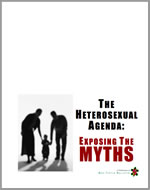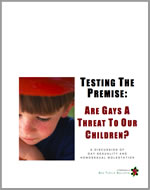Box Turtle Bulletin
 News and commentary about the anti-gay lobby
News and commentary about the anti-gay lobby News and commentary about the anti-gay lobby
News and commentary about the anti-gay lobbyPosts Tagged As: Personality Differences
April 16th, 2008
Social conservatives who oppose same-sex marriage often point to personality differences between men and women — the complementarity of the sexes, they call it — and consider these differences to be innate in men and women. Men are more aggressive and women are nurturing; it’s “in their genes.” But when we see evidence that the personalities of gay men and women have more in common with their heterosexual opposite-sex counterparts, then somehow the environment is blamed. Now a series of studies calls those assumptions into question.
Researcher Richard A. Lippa wrote an article for American Sexuality magazine in which he describes the studies he’s been performing over the past ten years. In these studies, he measured five human personality traits: extroversion, conscientiousness, agreeableness, neuroticism (negative emotionality) and openness to new experiences. To that, he added two more measures: instrumentality (independence, assertiveness, and leadership ability) and expressiveness (warmth, nurturance, and tenderness). And then he just asked two more questions point blank: Are you more interested in masculine things or feminine things? And do you consider yourself masculine or feminine?
Over the past decade, he asked all this of 2,724 heterosexual men, 799 gay men, 5,053 heterosexual women, and 697 lesbian women. This way he could make direct heterosexual male-female comparison, and compare those with differences between heterosexual men and gay men, and heterosexual women and lesbians. The results are shown in the table below. Personality Differences are given in terms of “effect sizes,” a common statistical measurement for experiments. In psychology, effect sizes 0.2, 0.5, and 0.8 are considered to be “small,” “medium,” and “large,” respectively. A positive number simply means the first group is higher than the second; a negative number means the second group is higher than the first.
| Personality Trait | Hetero Male -Female Differences |
Hetero Male -Gay Male Differences |
Hetero Female -Lesbian Differences |
|---|---|---|---|
| Extroversion | -.19 | -.08 | .04 |
| Agreeableness | -.21 | -.22 | -.01 |
| Conscientiousness | -.17 | -.30 | .05 |
| Neuroticism | -.48 | -.20 | .30 |
| Openness | .20 | -.42 | -.47 |
| Instrumentality | .22 | .04 | -.27 |
| Expressiveness | -.49 | -.37 | .04 |
| Masculinity-Femininity of Interests | 2.65 | 1.28 | -1.46 |
| Self-Ascribed Masculinity-Femininity | 2.83 | .60 | -1.28 |
Dr. Lippa noted:
Gay men were somewhat higher than straight men on agreeableness, conscientiousness, neuroticism, openness, and expressiveness. Except for openness to experience, gay-straight male differences mirrored male-female differences—that is, traits that gay men scored higher on than straight men were also traits that women scored higher on than men, and vice versa. The really big gay-straight male difference was for M-F of interests. Gay men had much more feminine occupational and hobby preferences than heterosexual men did. To give you a sense of the magnitude of this difference, the effect size listed in Table 1 implies that 90% of gay men have interests that are more feminine than the average straight man’s. Interestingly, the gay-straight male difference in self-ascribed M-F was more modest, and I suspect this is due to the fact that many gay men (like many straight men) don’t like to openly rate themselves as being “feminine.”
What were the corresponding results for women? Lesbian women were somewhat higher on openness and instrumentality than straight women were, and they were somewhat lower on neuroticism. As was true for the corresponding results for men, lesbian-straight female differences mirrored male-female differences—that is, traits that lesbians scored higher on than straight women were also traits that men scored higher on than women, and vice versa. The really big lesbian-straight female differences were for M-F of interests and self-ascribed M-F. Lesbian women had much more masculine occupational and hobby preferences than heterosexual women did. The effect size for this difference implies that 93% of lesbian women had interests that were more masculine than the average straight woman’s. Furthermore, lesbians rated themselves to be considerably more masculine and less feminine than straight women did. Thus, lesbians seemed to openly acknowledge and embrace their masculinity more than gay men acknowledged and embraced their femininity.
Does this mean that gays and lesbians are “born that way”? Dr. Lippa thinks this may lend credence to that position, although this study doesn’t prove it one way or another. But this does raise an interesting point. If straight men are more open to new experiences and straight women are more expressive because “they’re born that way,” then why do social conservatives blame opposite-gender traits in gay men and women on bad parenting?
Same-sex marriage opponents and ex-gay advocates have a pretty fundamental contradiction in their logic. Somehow I doubt we’ll see them addressing this anytime soon.
Hat tip: BTB reader Steve M.
Featured Reports
 In this original BTB Investigation, we unveil the tragic story of Kirk Murphy, a four-year-old boy who was treated for “cross-gender disturbance” in 1970 by a young grad student by the name of George Rekers. This story is a stark reminder that there are severe and damaging consequences when therapists try to ensure that boys will be boys.
In this original BTB Investigation, we unveil the tragic story of Kirk Murphy, a four-year-old boy who was treated for “cross-gender disturbance” in 1970 by a young grad student by the name of George Rekers. This story is a stark reminder that there are severe and damaging consequences when therapists try to ensure that boys will be boys.
When we first reported on three American anti-gay activists traveling to Kampala for a three-day conference, we had no idea that it would be the first report of a long string of events leading to a proposal to institute the death penalty for LGBT people. But that is exactly what happened. In this report, we review our collection of more than 500 posts to tell the story of one nation’s embrace of hatred toward gay people. This report will be updated continuously as events continue to unfold. Check here for the latest updates.
In 2005, the Southern Poverty Law Center wrote that “[Paul] Cameron’s ‘science’ echoes Nazi Germany.” What the SPLC didn”t know was Cameron doesn’t just “echo” Nazi Germany. He quoted extensively from one of the Final Solution’s architects. This puts his fascination with quarantines, mandatory tattoos, and extermination being a “plausible idea” in a whole new and deeply disturbing light.
On February 10, I attended an all-day “Love Won Out” ex-gay conference in Phoenix, put on by Focus on the Family and Exodus International. In this series of reports, I talk about what I learned there: the people who go to these conferences, the things that they hear, and what this all means for them, their families and for the rest of us.
Prologue: Why I Went To “Love Won Out”
Part 1: What’s Love Got To Do With It?
Part 2: Parents Struggle With “No Exceptions”
Part 3: A Whole New Dialect
Part 4: It Depends On How The Meaning of the Word "Change" Changes
Part 5: A Candid Explanation For "Change"
 At last, the truth can now be told.
At last, the truth can now be told.
Using the same research methods employed by most anti-gay political pressure groups, we examine the statistics and the case studies that dispel many of the myths about heterosexuality. Download your copy today!
And don‘t miss our companion report, How To Write An Anti-Gay Tract In Fifteen Easy Steps.
 Anti-gay activists often charge that gay men and women pose a threat to children. In this report, we explore the supposed connection between homosexuality and child sexual abuse, the conclusions reached by the most knowledgeable professionals in the field, and how anti-gay activists continue to ignore their findings. This has tremendous consequences, not just for gay men and women, but more importantly for the safety of all our children.
Anti-gay activists often charge that gay men and women pose a threat to children. In this report, we explore the supposed connection between homosexuality and child sexual abuse, the conclusions reached by the most knowledgeable professionals in the field, and how anti-gay activists continue to ignore their findings. This has tremendous consequences, not just for gay men and women, but more importantly for the safety of all our children.
Anti-gay activists often cite the “Dutch Study” to claim that gay unions last only about 1½ years and that the these men have an average of eight additional partners per year outside of their steady relationship. In this report, we will take you step by step into the study to see whether the claims are true.
Tony Perkins’ Family Research Council submitted an Amicus Brief to the Maryland Court of Appeals as that court prepared to consider the issue of gay marriage. We examine just one small section of that brief to reveal the junk science and fraudulent claims of the Family “Research” Council.
 The FBI’s annual Hate Crime Statistics aren’t as complete as they ought to be, and their report for 2004 was no exception. In fact, their most recent report has quite a few glaring holes. Holes big enough for Daniel Fetty to fall through.
The FBI’s annual Hate Crime Statistics aren’t as complete as they ought to be, and their report for 2004 was no exception. In fact, their most recent report has quite a few glaring holes. Holes big enough for Daniel Fetty to fall through.